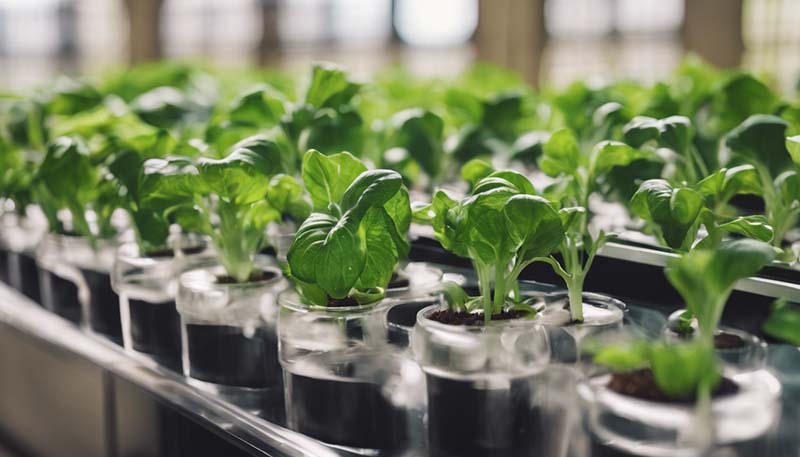Advanced Indoor Gardening: Hydroponics 101
Hydroponics is a method of growing plants without soil by using mineral nutrient solutions in a water solvent. This advanced indoor gardening technique offers numerous benefits, such as higher yields, better control over growing conditions, and the ability to grow food in places where soil is poor or unavailable. This article will serve as an introduction to the fascinating world of hydroponics, covering the basics you need to know to get started with your own hydroponic garden.
Understanding the Principles of Hydroponics
At the core of hydroponics is the understanding that plants draw their nutrients from the soil in a溶于水 soluble form. By providing these nutrients directly to the roots, hydroponic systems bypass the need for soil, which is primarily a medium for anchoring plants and facilitating nutrient uptake.
Advertisement
Types of Hydroponic Systems
There are several types of hydroponic systems, each with its own set of benefits and challenges:
- Wick System: Simple and beginner-friendly, where a wick draws nutrient solution up to the plant's roots.
- Nutrient Film Technique (NFT): A continuous flow of nutrient solution runs beneath the plant roots.
- Deep Water Culture (DWC): Plants' roots are suspended in a nutrient-rich, deep water bath with an air pump to provide oxygen.
- Aeroponics: Nutrients are delivered through a mist that surrounds the plant's roots, allowing for excellent oxygenation.
- Ebb and Flow (Flood and Drain): A tray of nutrient solution is filled and drained periodically.
Components of a Hydroponic System
To set up a hydroponic system, you will need the following components:
- Nutrient Solution: A pre-mixed or自制 solution containing essential nutrients for plant growth.
- Growing Medium: While not necessary, a medium like perlite, coconut coir, or rockwool can support plant roots.
- Container or System Structure: A structure to hold the plants and nutrient solution, like an NFT channel or a DWC bucket.
- Aeration and Circulation: An air pump and diffusers to oxygenate the nutrient solution and circulate it around the roots.
- Water Source: A source of water that is free of contaminants and has the correct pH level for plant nutrients.
- Lighting: Adequate lighting is crucial, as plants will rely on artificial light when grown indoors.
- pH and EC Meters: Tools to measure the pH (acidity or alkalinity) and electrical conductivity (nutrient concentration) of the nutrient solution.
Setting Up Your Hydroponic Garden
Once you have gathered the necessary components, follow these steps to set up your hydroponic garden:
- Choose a suitable location with enough space and access to electricity.
- Set up your system structure according to the type of hydroponics you've chosen.
- Prepare the nutrient solution, ensuring it has the right balance of nutrients and pH level.
- Introduce your plants to the system, either by starting with seeds or transplanting established plants.
- Set up and adjust your lighting to match the light requirements of your plants.
- Monitor and maintain the nutrient solution, pH, and EC levels regularly.
- Keep an eye on your plants for any signs of nutrient deficiencies or pests and address issues promptly.
Advantages of Hydroponic Gardening
Hydroponics offers several advantages over traditional soil gardening:
- Higher Yields: Plants grown hydroponically often produce higher yields due to optimized growing conditions.
- Faster Growth: Without the constraints of soil, plants can grow more quickly and efficiently.
- Less Space: Hydroponic systems can be more space-efficient, making them ideal for urban environments or small spaces.
- Water Efficiency: Hydroponics uses less water than traditional farming because the nutrient solution is recirculated.
- Year-Round Production: Indoor hydroponic systems allow for year-round growing, regardless of the outdoor climate.
- Less Pest and Disease Pressure: The controlled environment can reduce the risk of pests and diseases.
Challenges and Considerations
While hydroponics has many benefits, it also comes with its own set of challenges:

- Initial Investment: Setting up a hydroponic system can require a significant upfront cost.
- Technical Knowledge: Hydroponic gardening requires a good understanding of plant nutrition and system maintenance.
- Electricity Dependence: The reliance on electricity for lighting and aeration can be a drawback, especially in areas with high energy costs or unreliable power supply.
- System Failure Risk: If the system fails (e.g., pump stops working), it can quickly lead to plant loss.
Conclusion
Hydroponics is a versatile and efficient method of indoor gardening that can lead to bountiful harvests and a sustainable way of producing food. With careful planning, attention to detail, and a willingness to learn, anyone can successfully grow plants hydroponically. As you delve into the world of hydroponics, you'll find a supportive community of gardeners and a wealth of resources to help you on your journey to becoming an advanced indoor gardener.
Comment